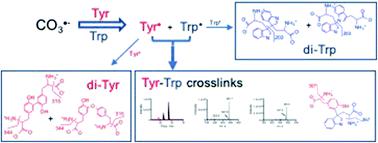Our official English website, www.x-mol.net, welcomes your feedback! (Note: you will need to create a separate account there.)
Formation and characterization of crosslinks, including Tyr–Trp species, on one electron oxidation of free Tyr and Trp residues by carbonate radical anion
RSC Advances ( IF 3.9 ) Pub Date : 2020-7-8 , DOI: 10.1039/d0ra04051g Juan David Figueroa 1 , Ana María Zárate 1 , Eduardo Fuentes-Lemus 1 , Michael J Davies 2 , Camilo López-Alarcón 1
RSC Advances ( IF 3.9 ) Pub Date : 2020-7-8 , DOI: 10.1039/d0ra04051g Juan David Figueroa 1 , Ana María Zárate 1 , Eduardo Fuentes-Lemus 1 , Michael J Davies 2 , Camilo López-Alarcón 1
Affiliation

|
Dityrosine and ditryptophan bonds have been implied in protein crosslinking. This is associated with oxidative stress conditions including those involved in neurodegenerative pathologies and age-related processes. Formation of dityrosine and ditryptophan derives from radical–radical reactions involving Tyr˙ and Trp˙ radicals. However, cross reactions of Tyr˙ and Trp˙ leading to Tyr–Trp crosslinks and their biological consequences have been less explored. In the present work we hypothesized that exposure of free Tyr and Trp to a high concentration of carbonate anion radicals (CO3˙−), under anaerobic conditions, would result in the formation of Tyr–Trp species, as well as dityrosine and ditryptophan crosslinks. Here we report a simple experimental procedure, employing CO3˙− generated photochemically by illumination of a Co(III) complex at 254 nm, that produces micromolar concentrations of Tyr–Trp crosslinks. Analysis by mass spectrometry of solutions containing only the individual amino acids, and the Co(III) complex, provided evidence for the formation of o,o′-dityrosine and isodityrosine from Tyr, and three ditryptophan dimers from Trp. When mixtures of Tyr and Trp were illuminated in an identical manner, Tyr–Trp crosslinks were detected together with dityrosine and ditryptophan dimers. These results indicate that there is a balance between the formation of these three classes of crosslinks, which is dependent on the Tyr and Trp concentrations. The methods reported here allow the generation of significant yields of isolated Tyr–Trp adducts and their characterization. This technology should facilitate the detection, and examination of the biological consequences of Tyr–Trp crosslink formation in complex systems in future investigations.
中文翻译:

碳酸盐自由基阴离子对游离 Tyr 和 Trp 残基的一电子氧化形成和表征交联,包括 Tyr-Trp 物种
蛋白质交联中暗示了二酪氨酸和二色氨酸键。这与氧化应激条件有关,包括那些涉及神经退行性疾病和年龄相关过程的条件。二酪氨酸和二色氨酸的形成来源于涉及 Tyr˙ 和 Trp˙ 自由基的自由基反应。然而,Tyr˙ 和 Trp˙ 的交叉反应导致 Tyr-Trp 交联及其生物学后果的研究较少。在目前的工作中,我们假设在厌氧条件下,游离 Tyr 和 Trp 暴露于高浓度的碳酸盐阴离子自由基 (CO 3 ˙ - ) 会导致 Tyr-Trp 物种以及二酪氨酸和二色氨酸交联的形成. 在这里,我们报告了一个简单的实验程序,采用 CO 3˙ -通过在 254 nm 处照射 Co( III ) 复合物以光化学方式产生,产生微摩尔浓度的 Tyr-Trp 交联。对仅含有单个氨基酸和 Co( III ) 复合物的溶液进行质谱分析,为o、o的形成提供了证据来自 Tyr 的 '-二酪氨酸和异酪氨酸,以及来自 Trp 的三个二色氨酸二聚体。当 Tyr 和 Trp 的混合物以相同的方式照射时,Tyr-Trp 交联与二酪氨酸和二色氨酸二聚体一起被检测到。这些结果表明这三类交联的形成之间存在平衡,这取决于 Tyr 和 Trp 浓度。这里报告的方法允许产生大量分离的 Tyr-Trp 加合物及其表征。在未来的研究中,这项技术应该有助于检测和检查复杂系统中 Tyr-Trp 交联形成的生物学后果。
更新日期:2020-07-08
中文翻译:

碳酸盐自由基阴离子对游离 Tyr 和 Trp 残基的一电子氧化形成和表征交联,包括 Tyr-Trp 物种
蛋白质交联中暗示了二酪氨酸和二色氨酸键。这与氧化应激条件有关,包括那些涉及神经退行性疾病和年龄相关过程的条件。二酪氨酸和二色氨酸的形成来源于涉及 Tyr˙ 和 Trp˙ 自由基的自由基反应。然而,Tyr˙ 和 Trp˙ 的交叉反应导致 Tyr-Trp 交联及其生物学后果的研究较少。在目前的工作中,我们假设在厌氧条件下,游离 Tyr 和 Trp 暴露于高浓度的碳酸盐阴离子自由基 (CO 3 ˙ - ) 会导致 Tyr-Trp 物种以及二酪氨酸和二色氨酸交联的形成. 在这里,我们报告了一个简单的实验程序,采用 CO 3˙ -通过在 254 nm 处照射 Co( III ) 复合物以光化学方式产生,产生微摩尔浓度的 Tyr-Trp 交联。对仅含有单个氨基酸和 Co( III ) 复合物的溶液进行质谱分析,为o、o的形成提供了证据来自 Tyr 的 '-二酪氨酸和异酪氨酸,以及来自 Trp 的三个二色氨酸二聚体。当 Tyr 和 Trp 的混合物以相同的方式照射时,Tyr-Trp 交联与二酪氨酸和二色氨酸二聚体一起被检测到。这些结果表明这三类交联的形成之间存在平衡,这取决于 Tyr 和 Trp 浓度。这里报告的方法允许产生大量分离的 Tyr-Trp 加合物及其表征。在未来的研究中,这项技术应该有助于检测和检查复杂系统中 Tyr-Trp 交联形成的生物学后果。


























 京公网安备 11010802027423号
京公网安备 11010802027423号